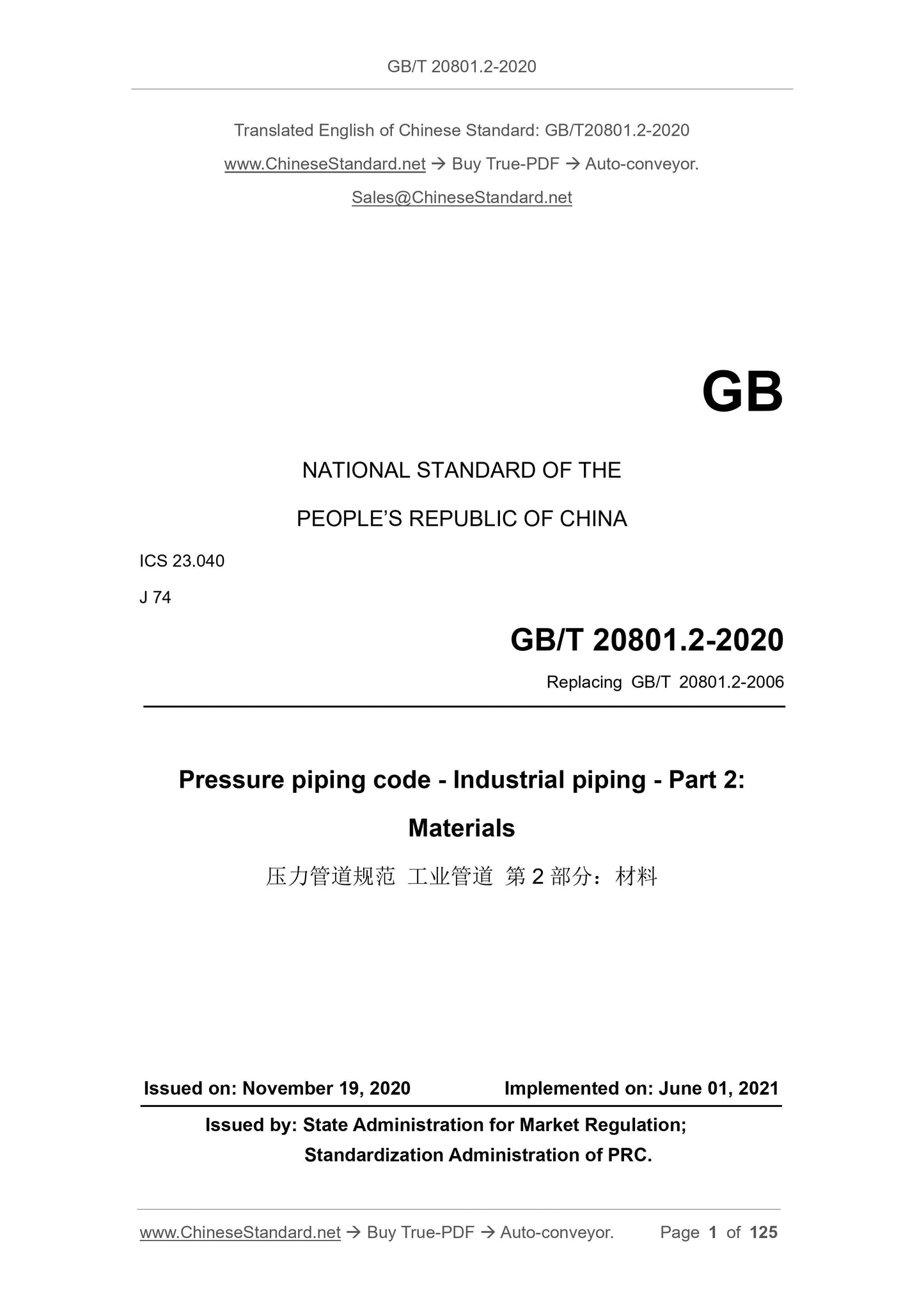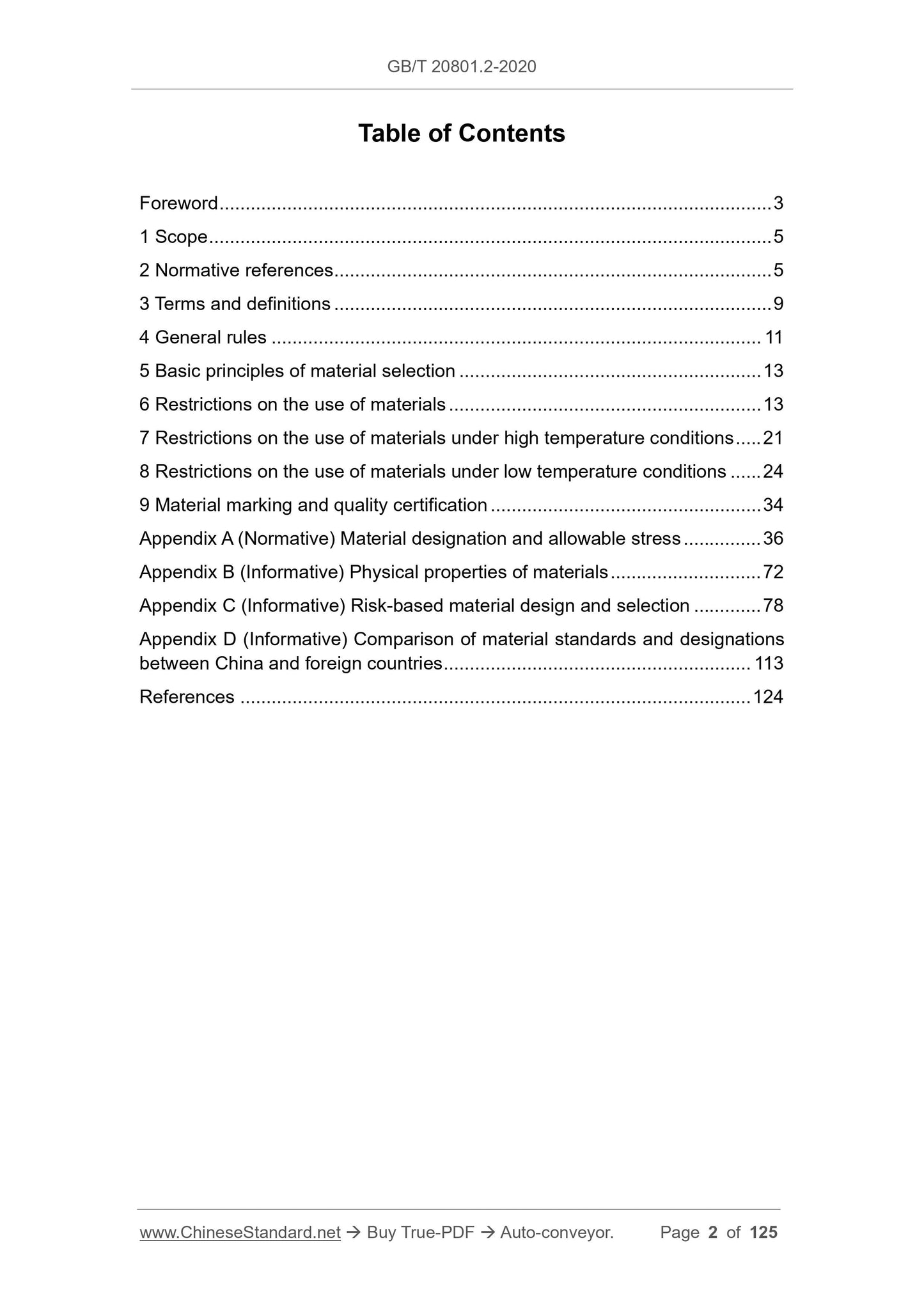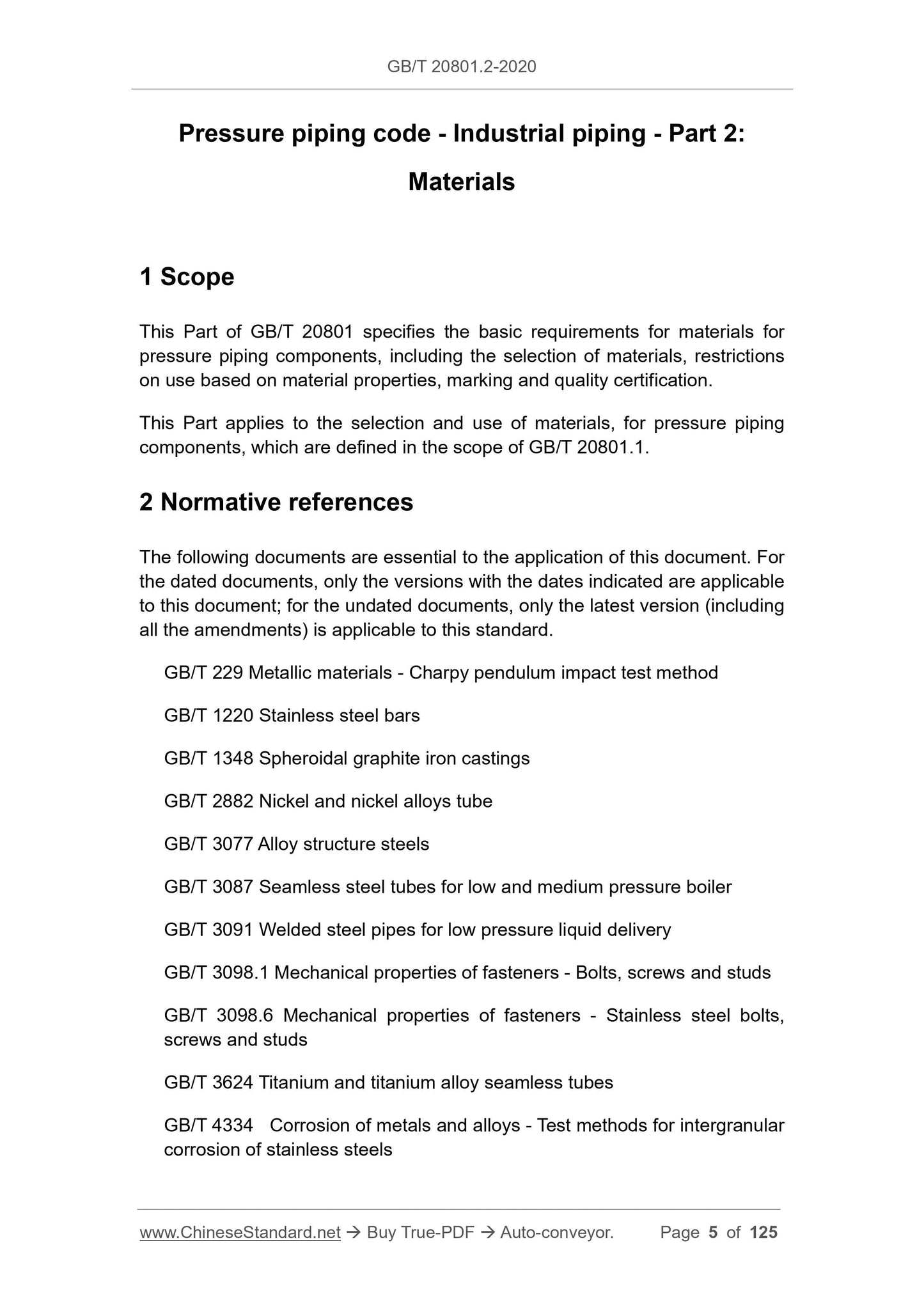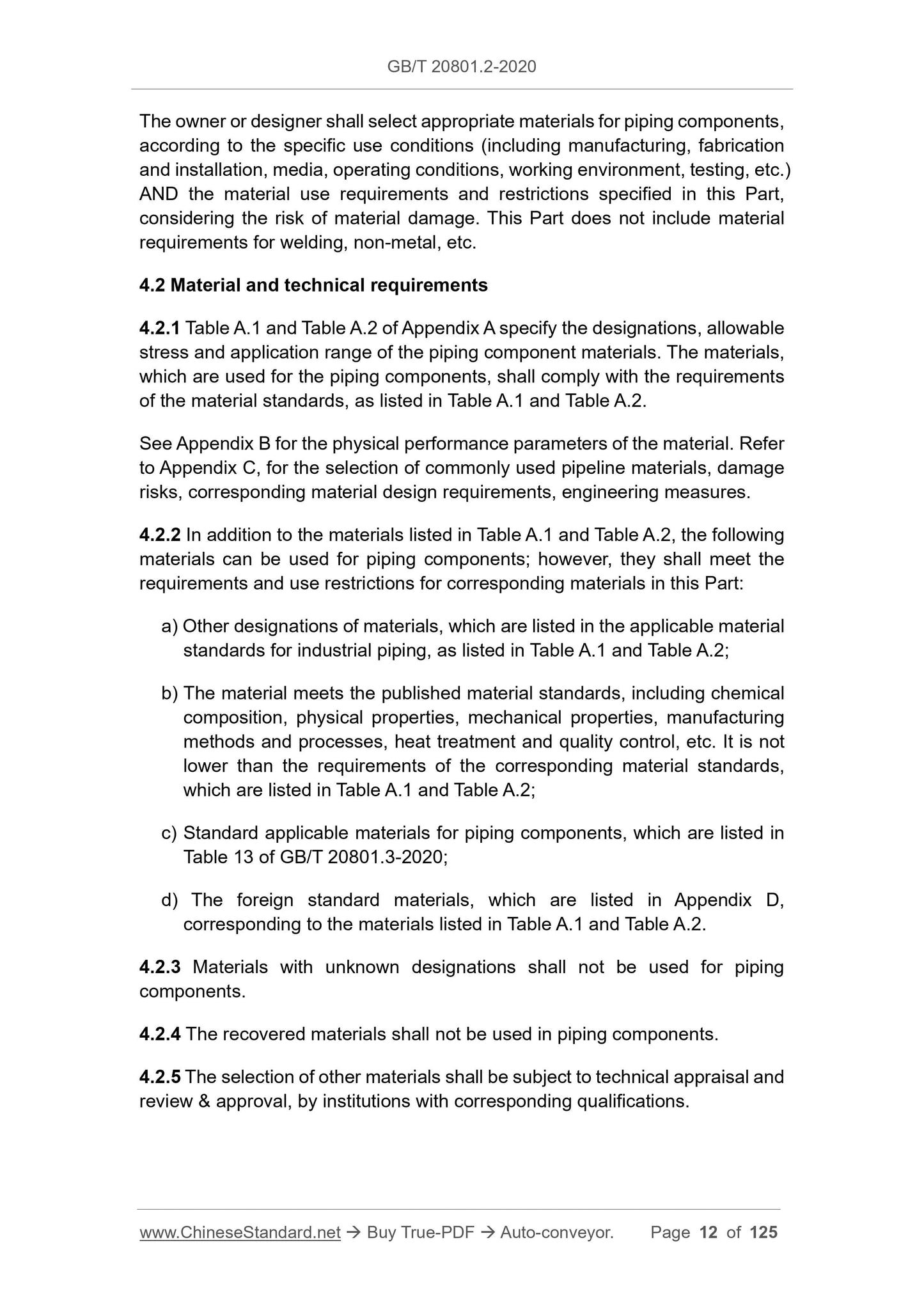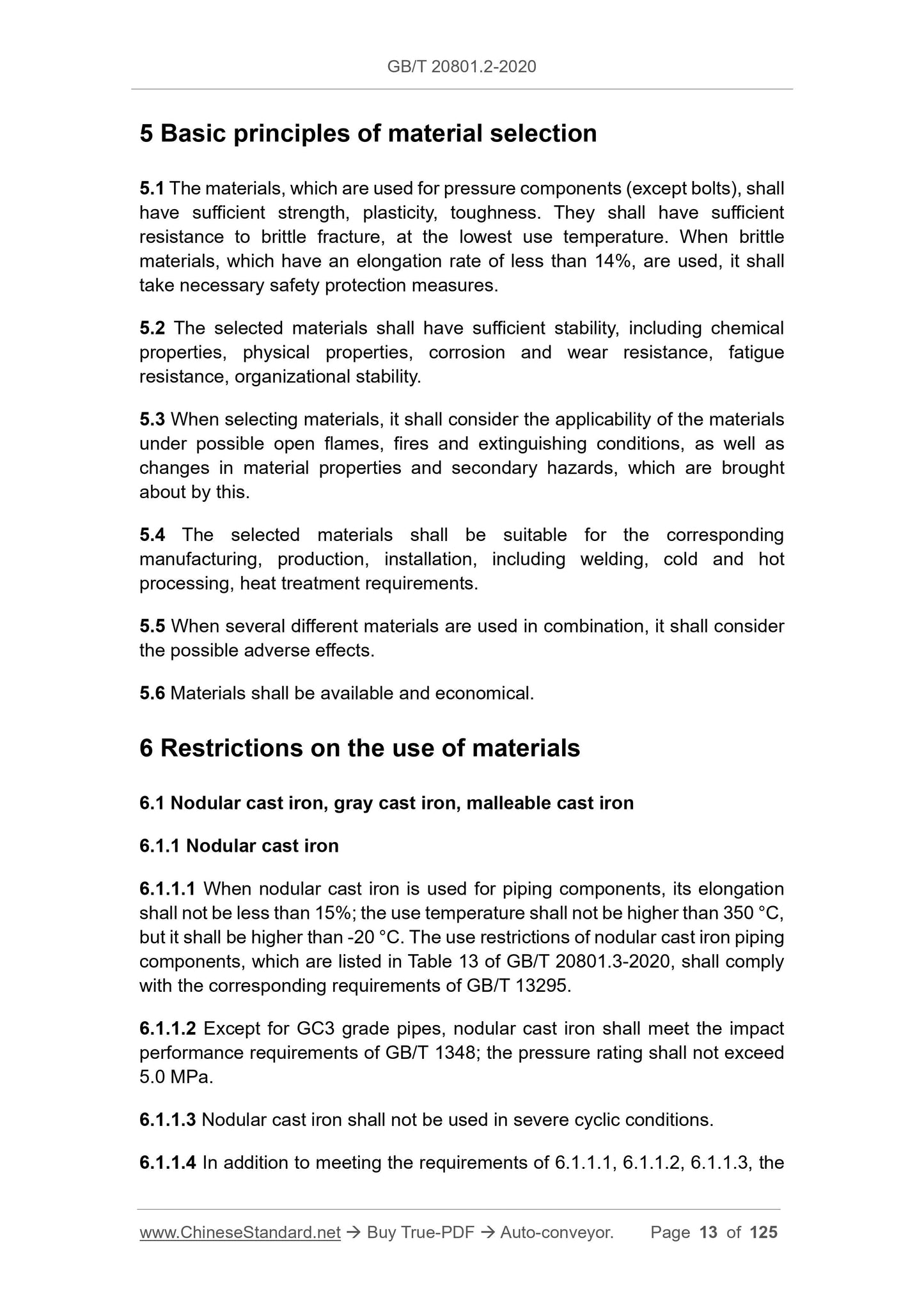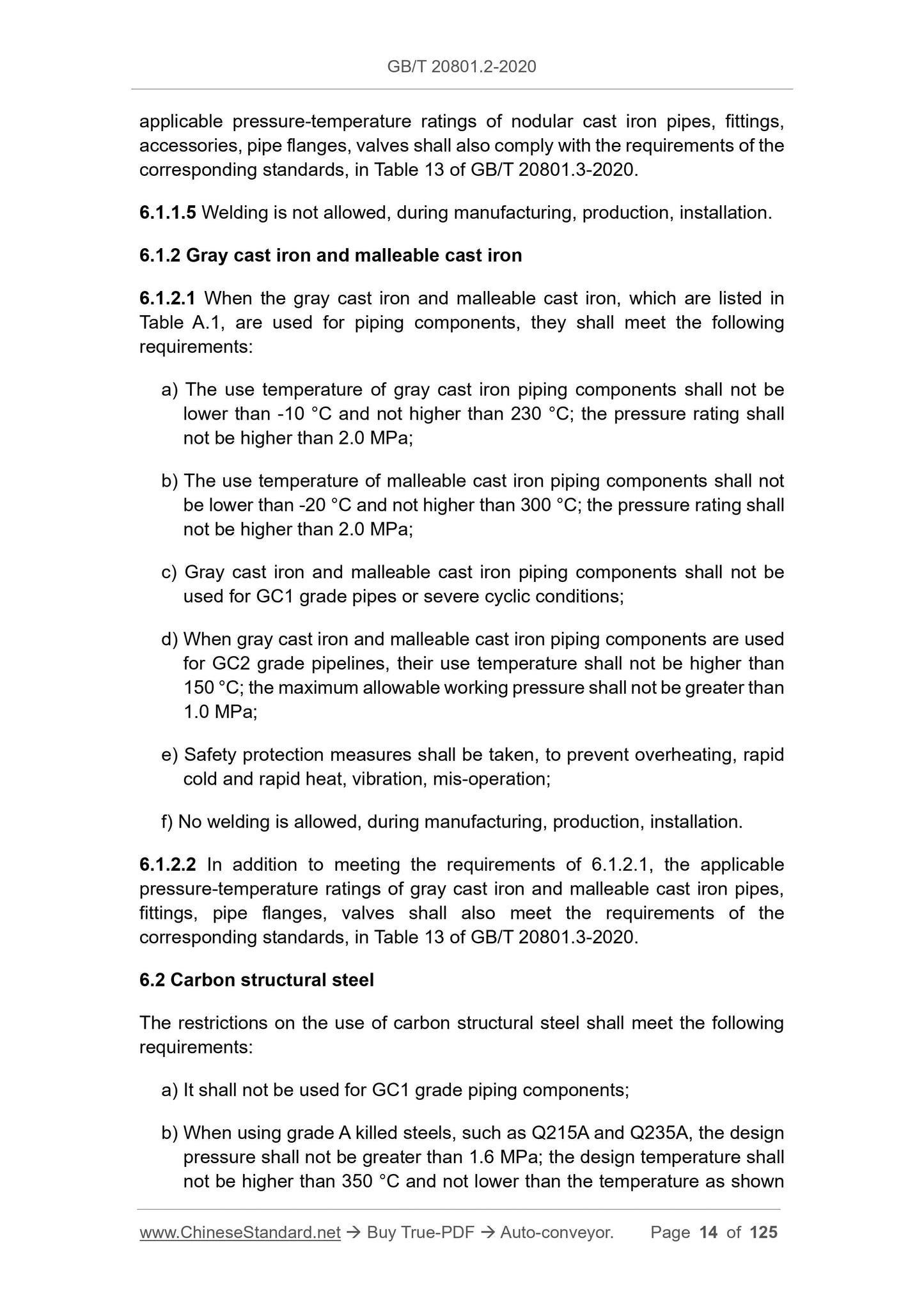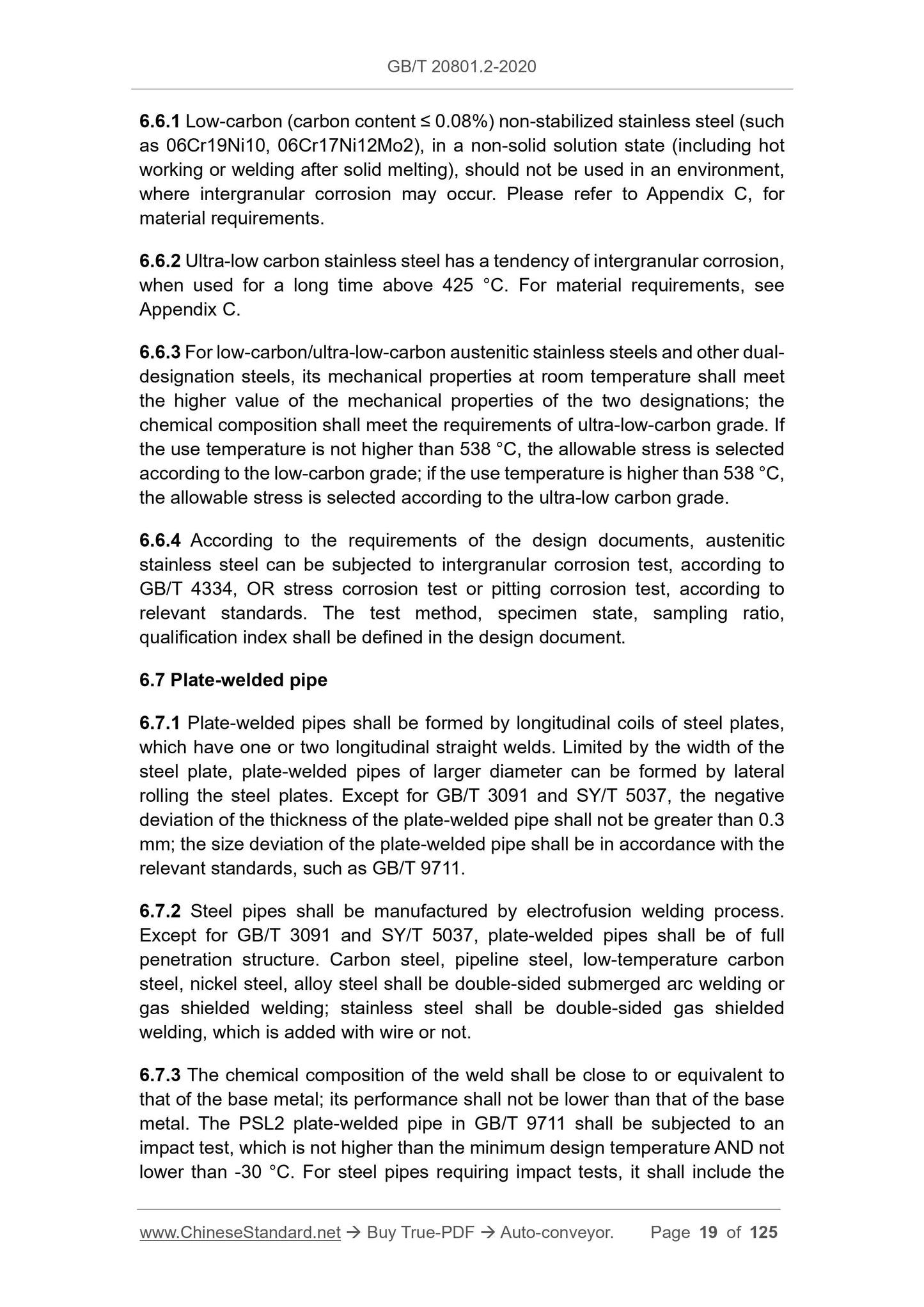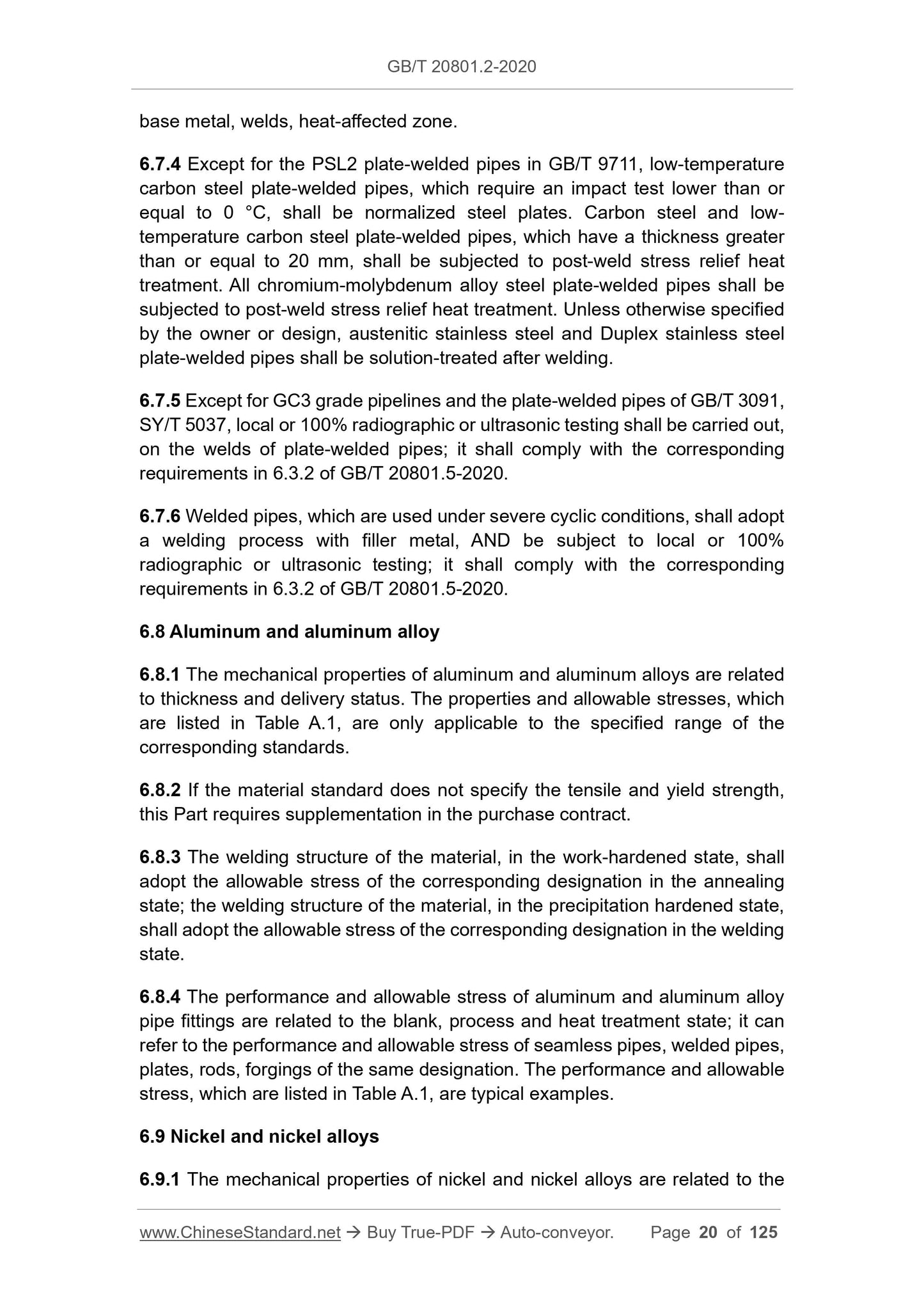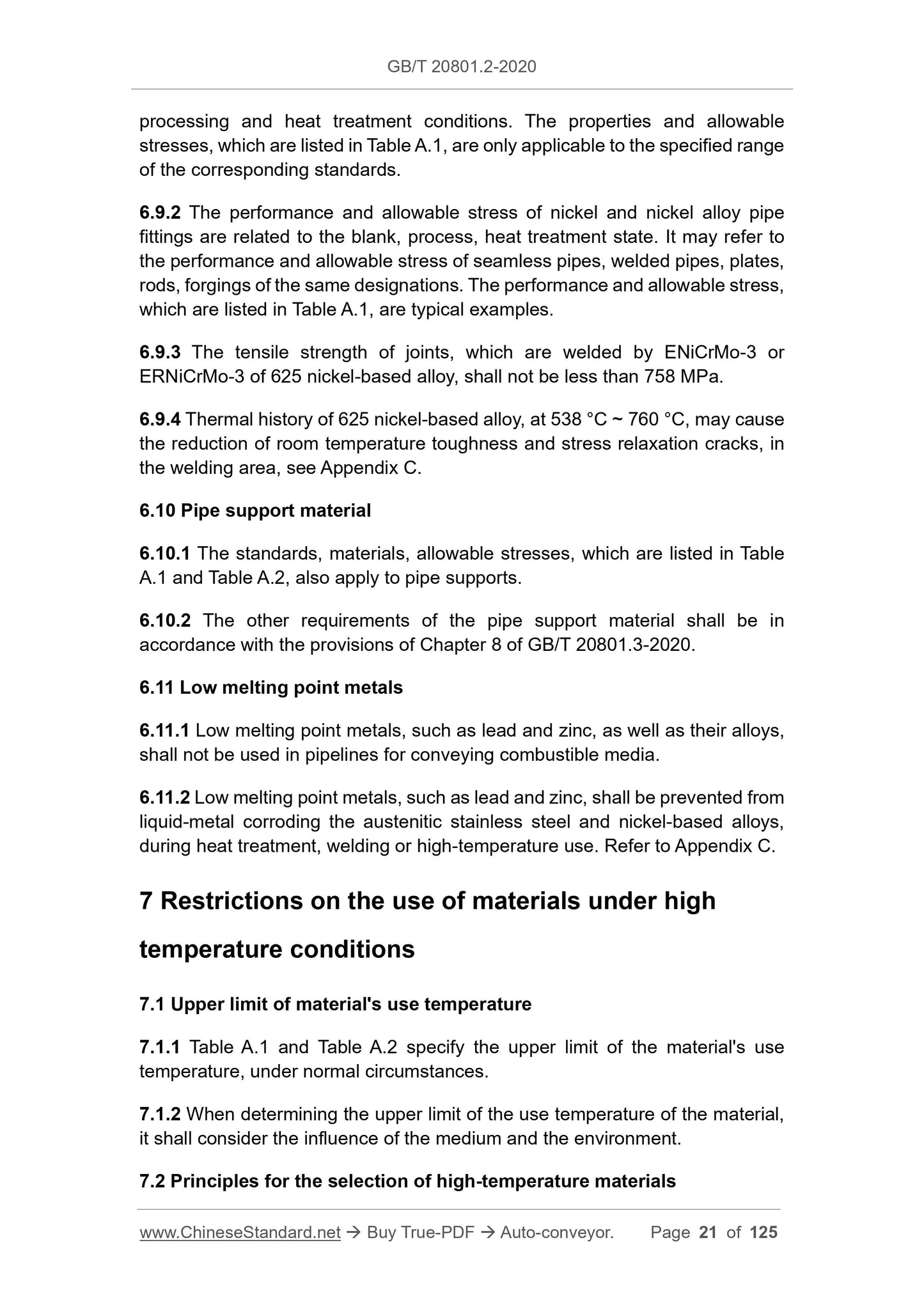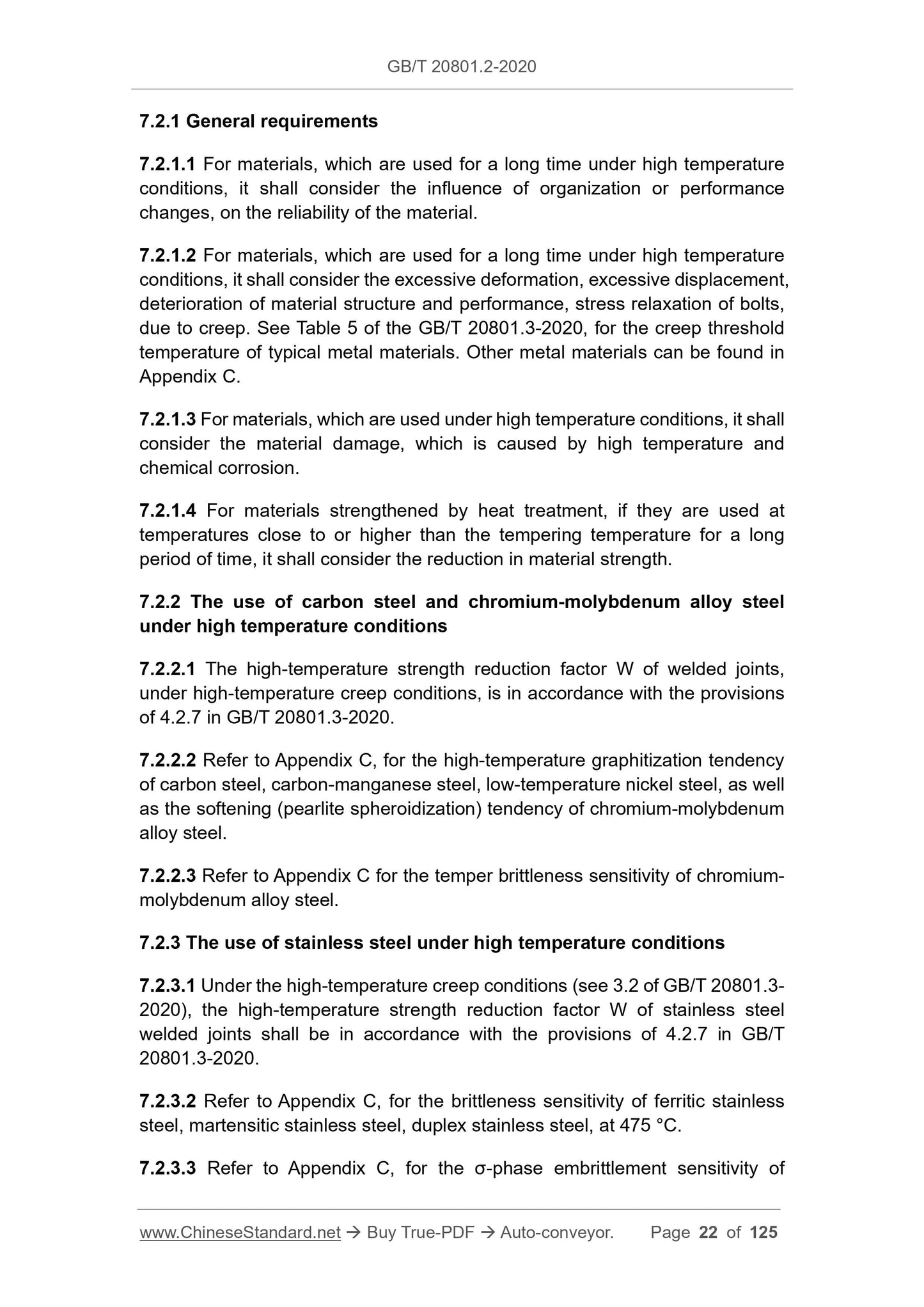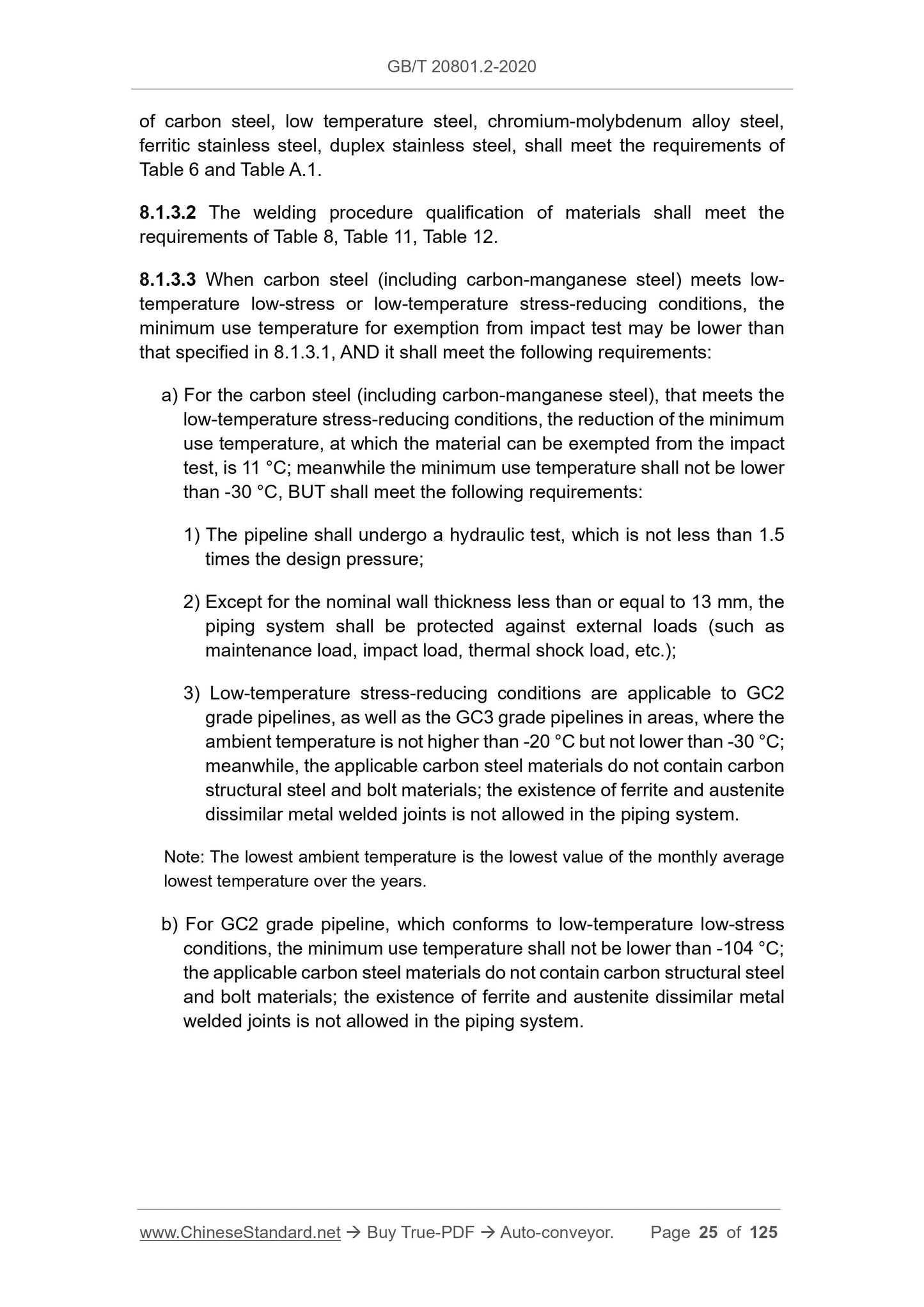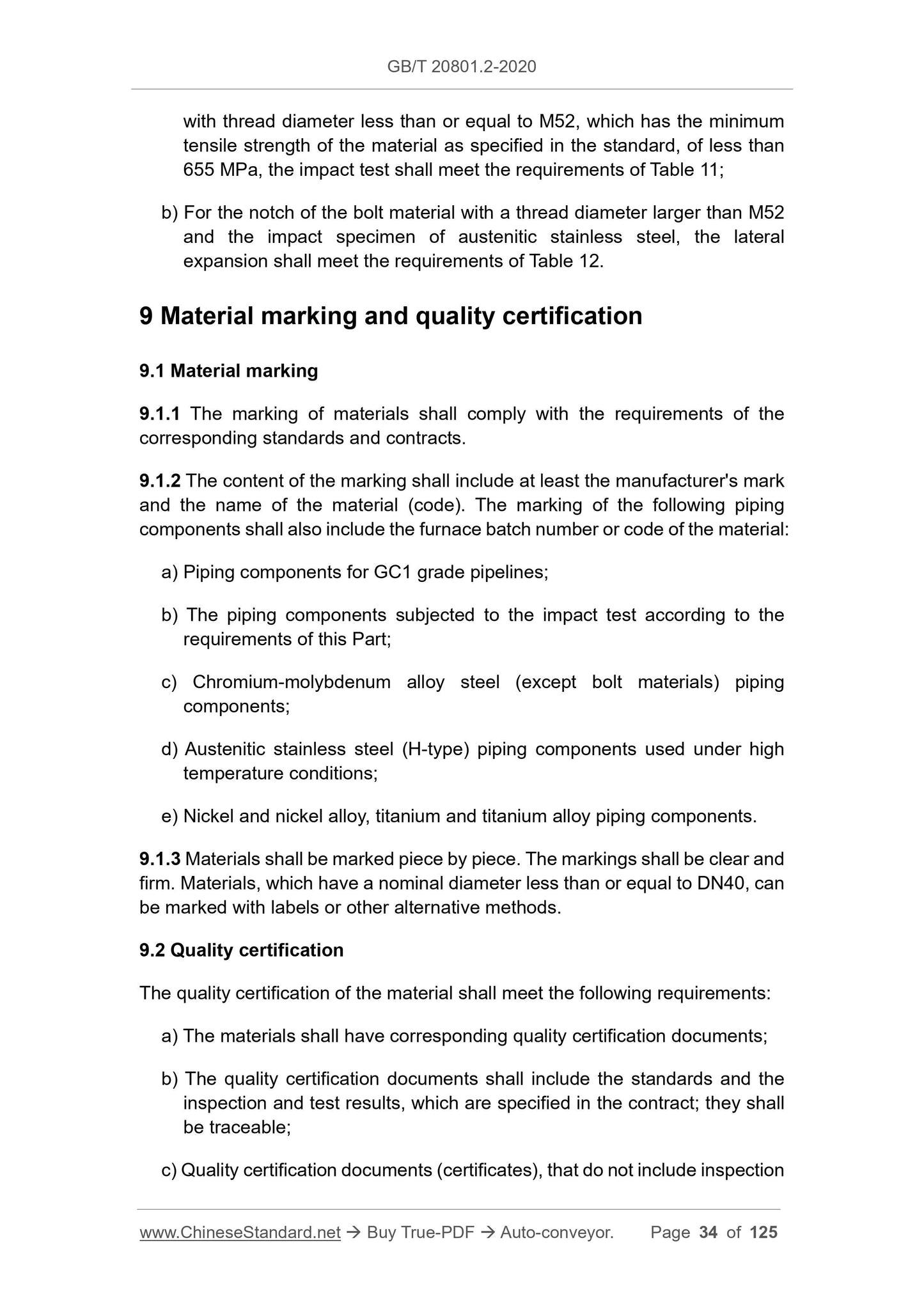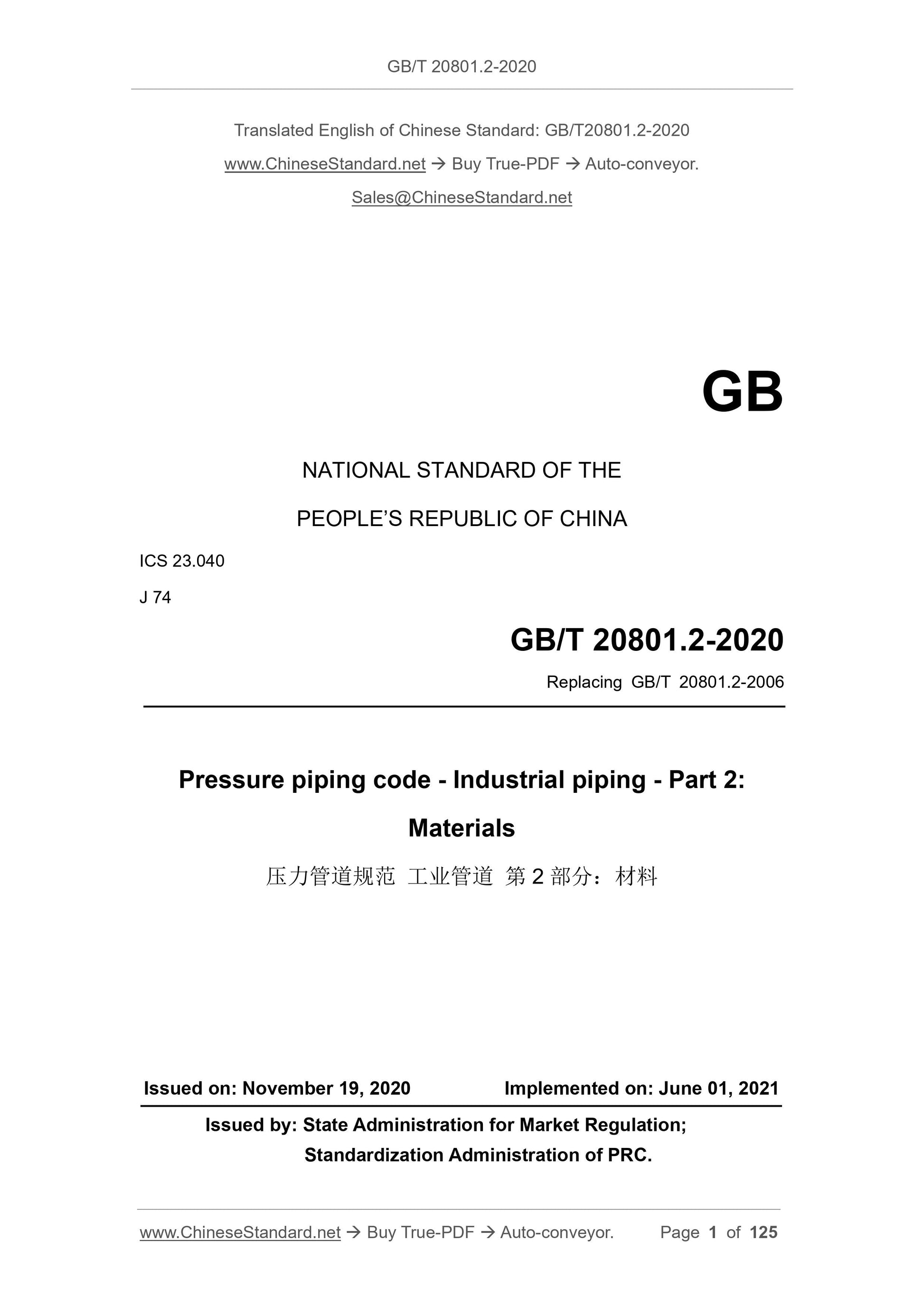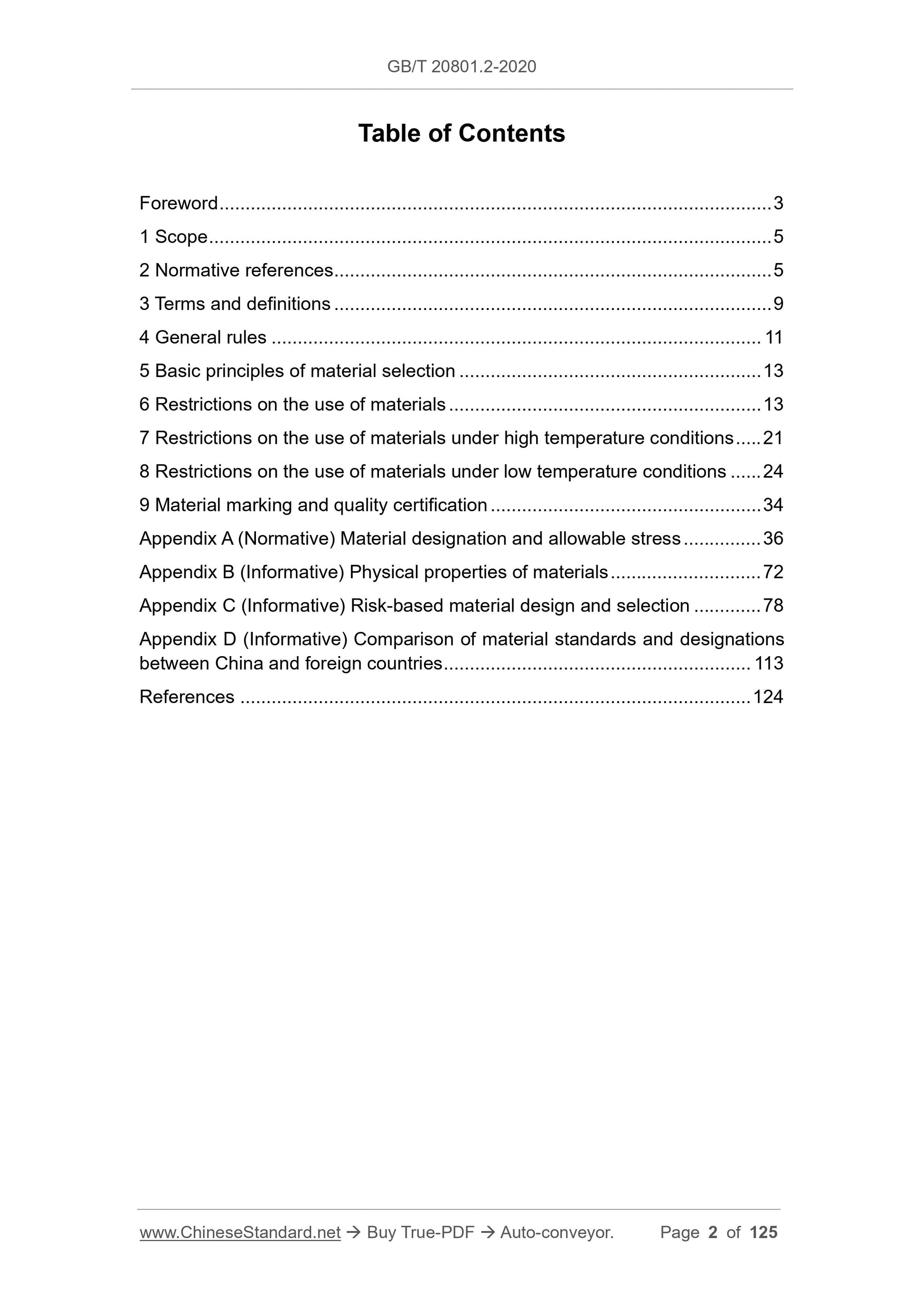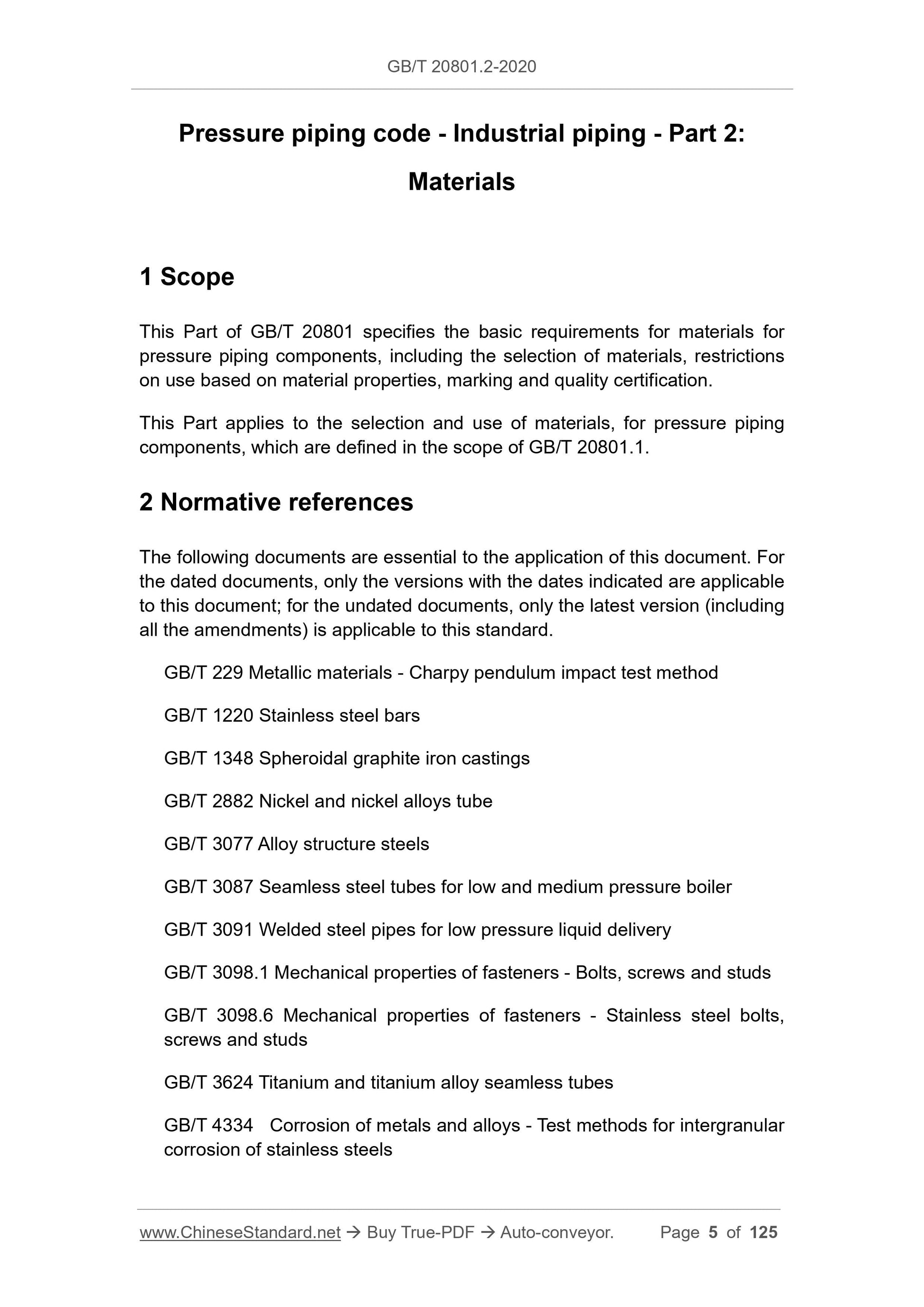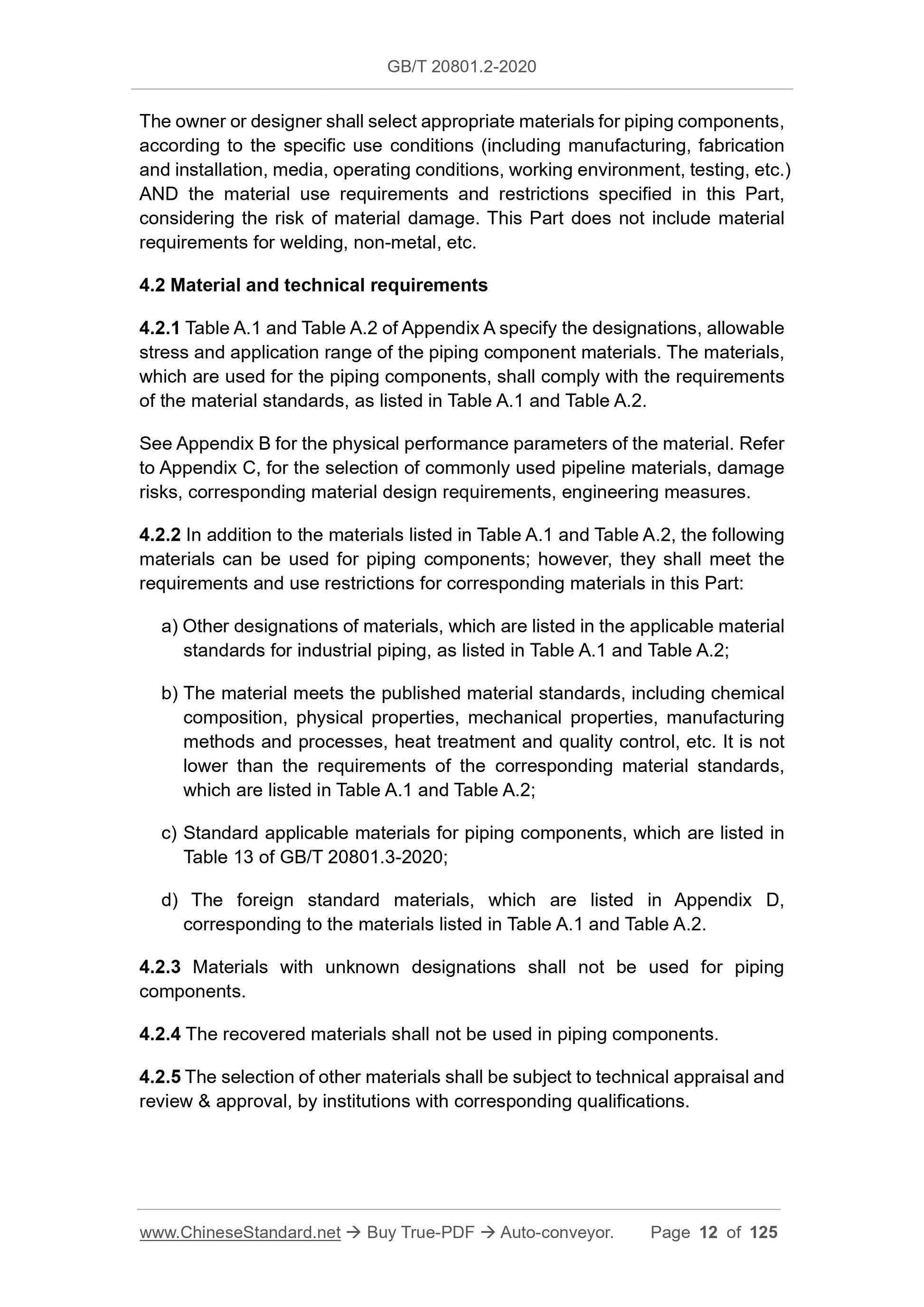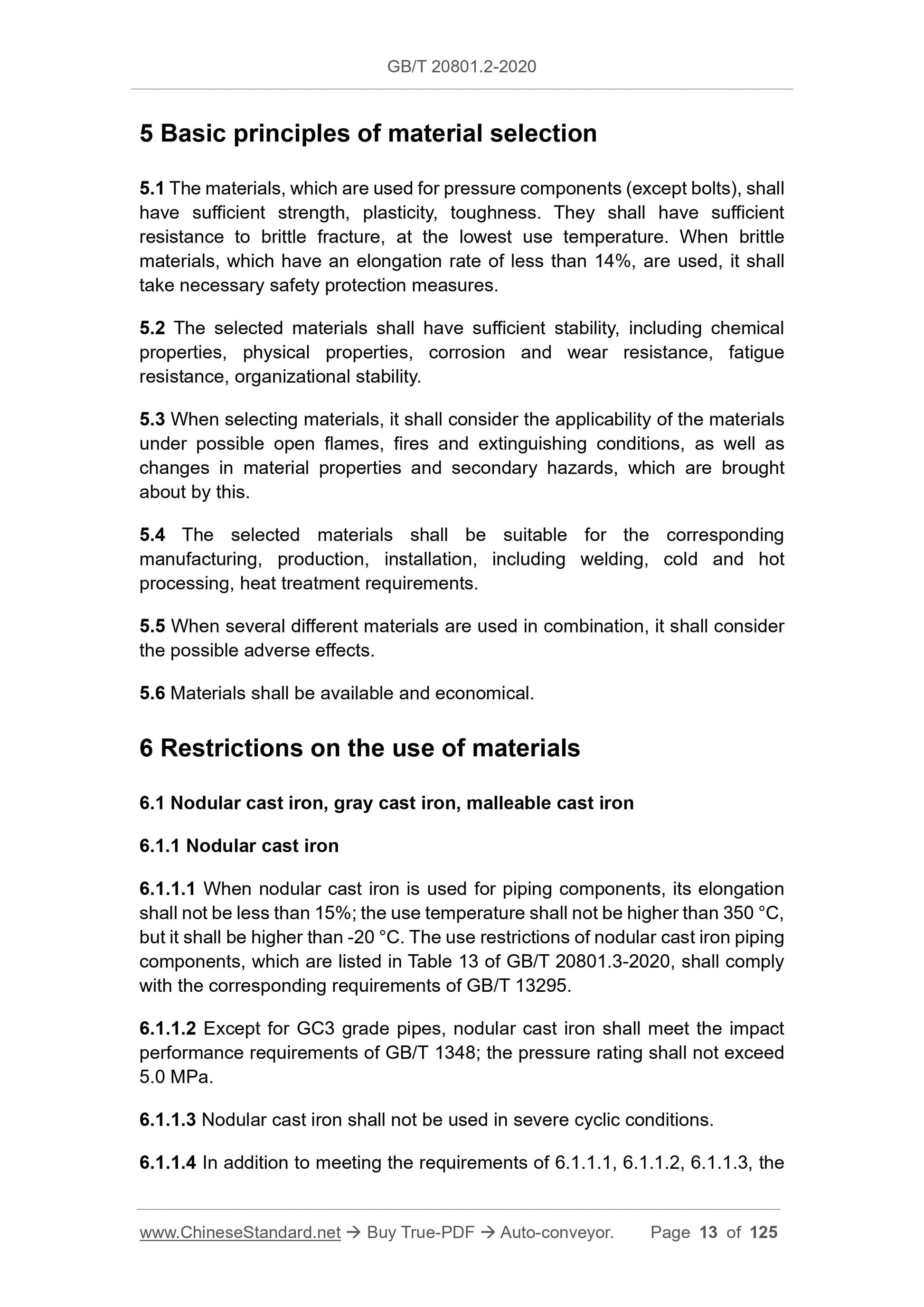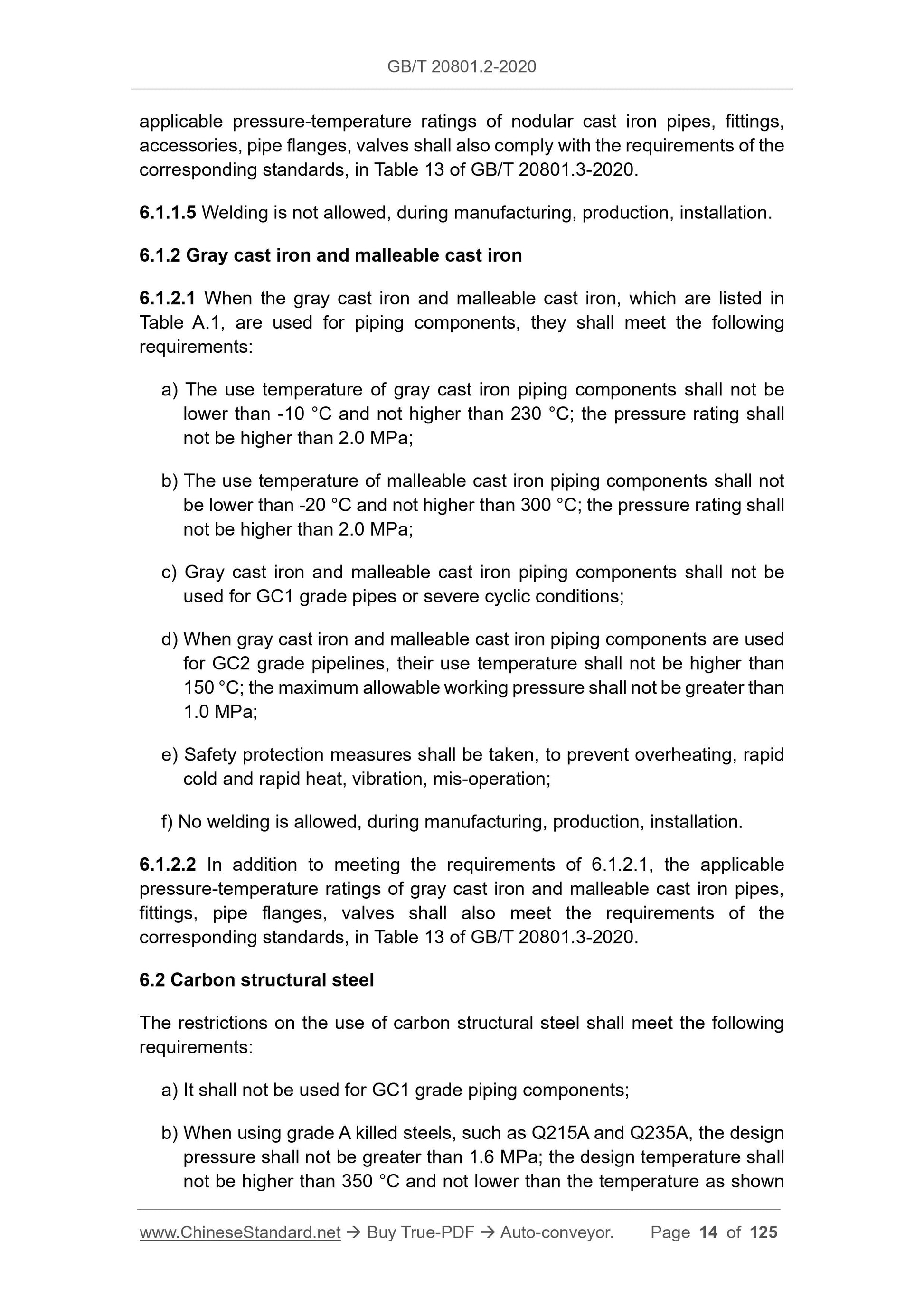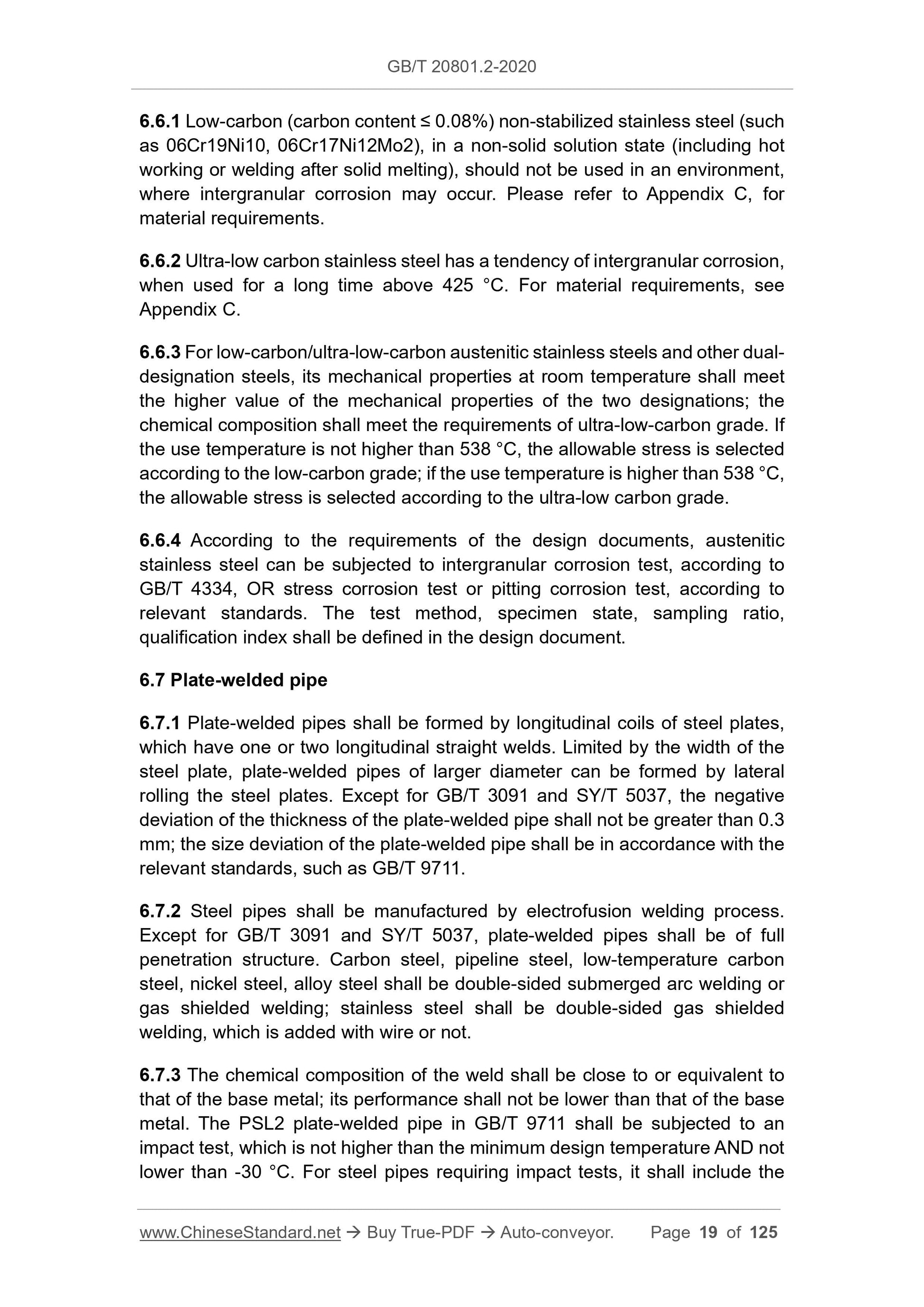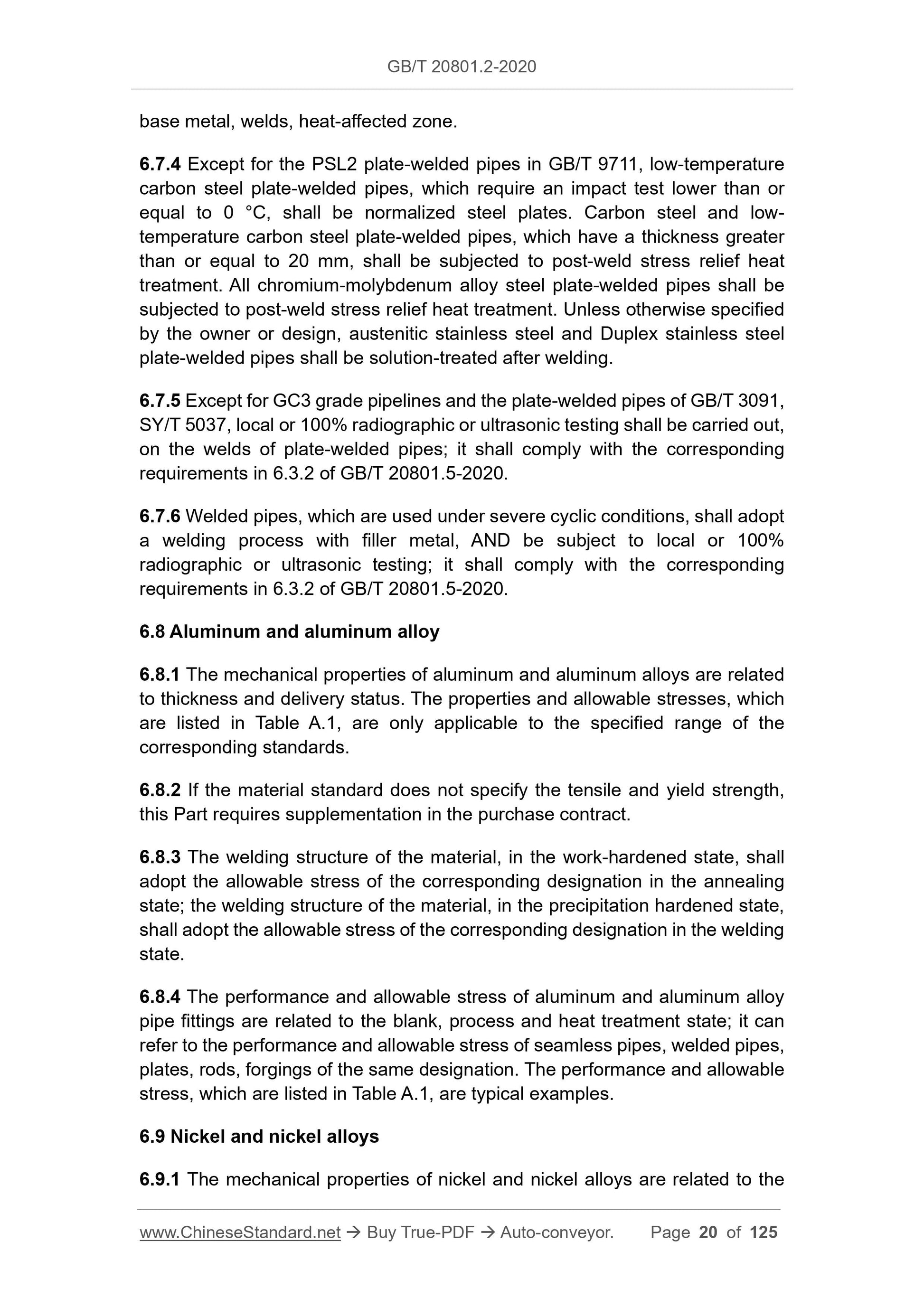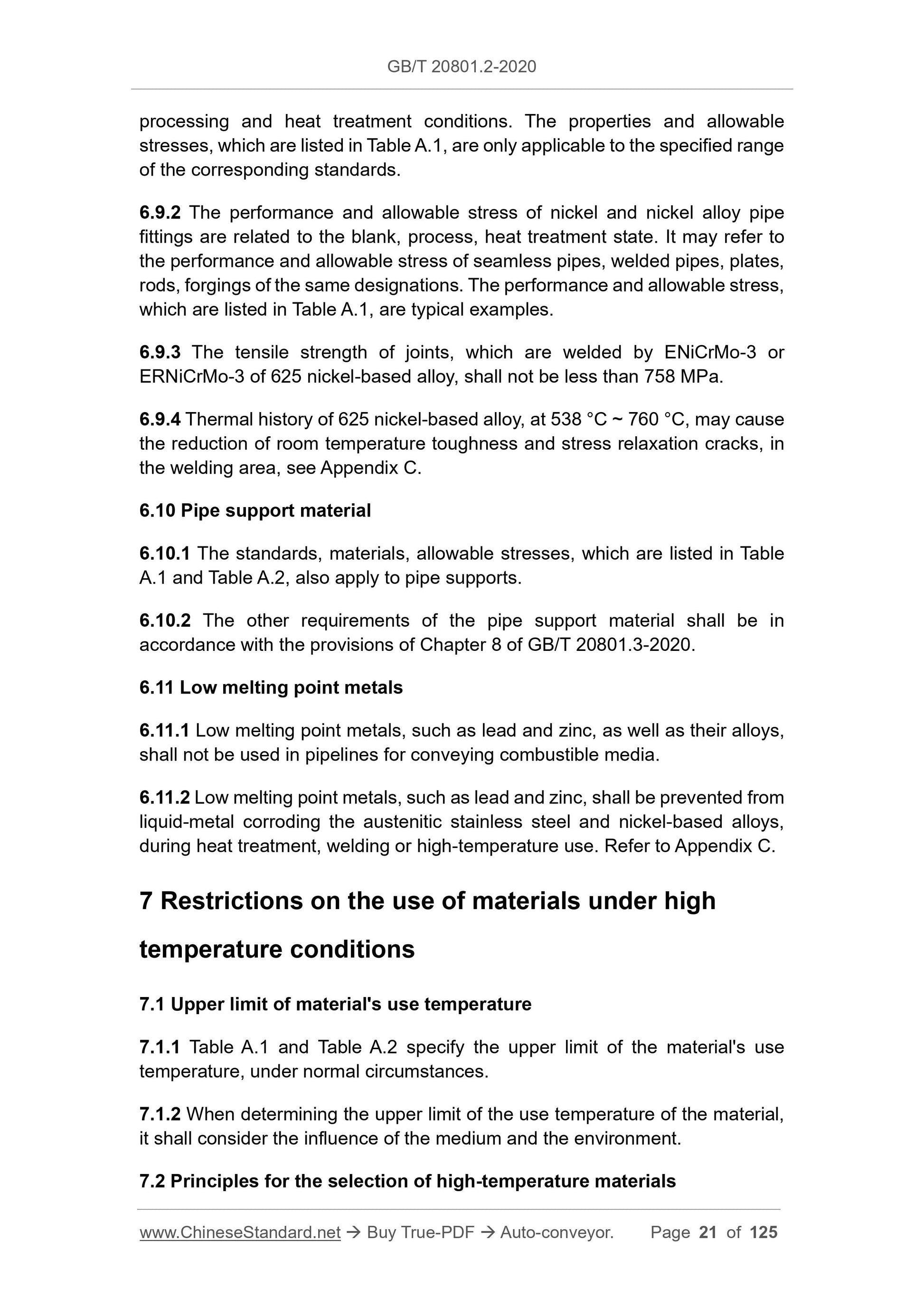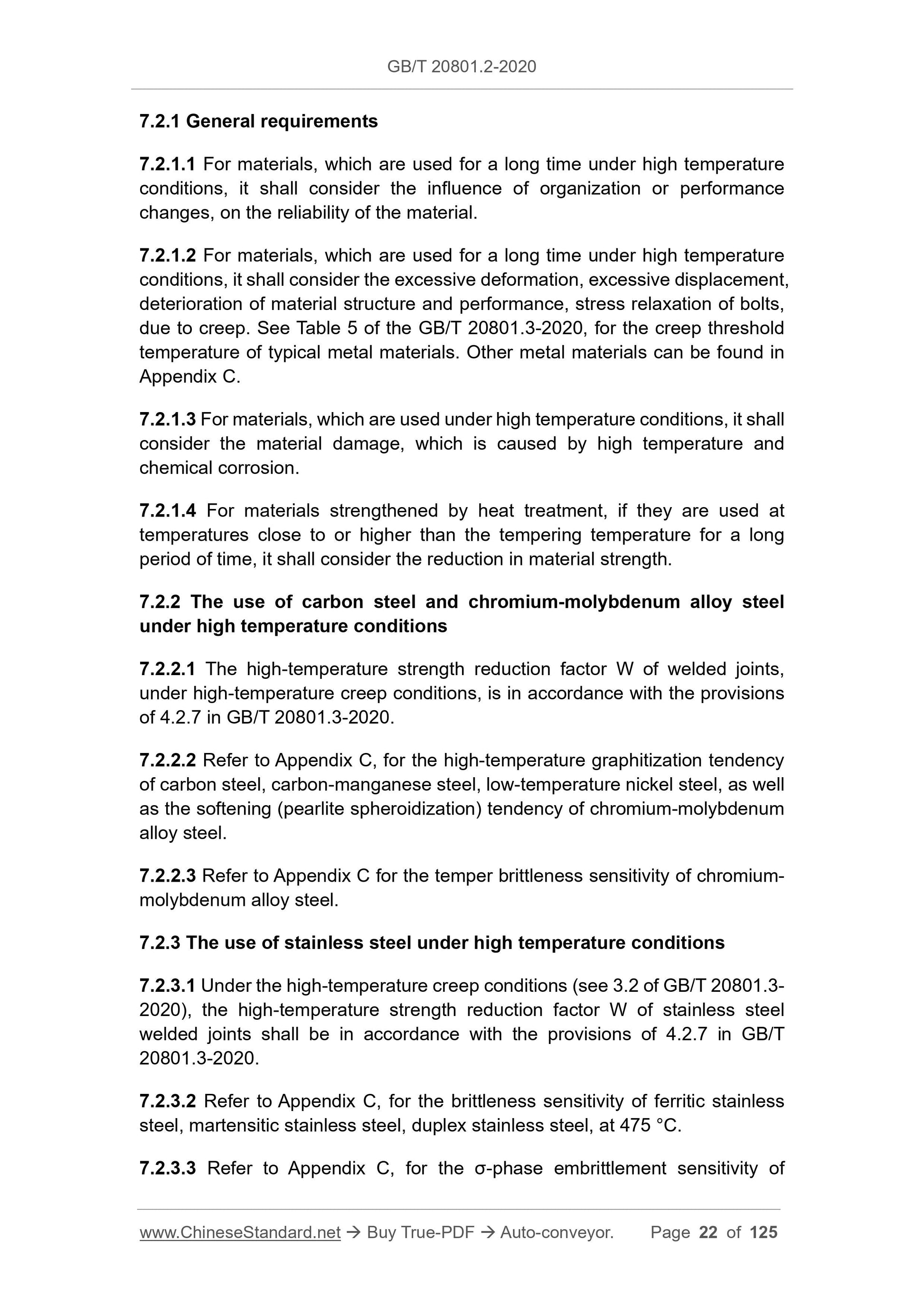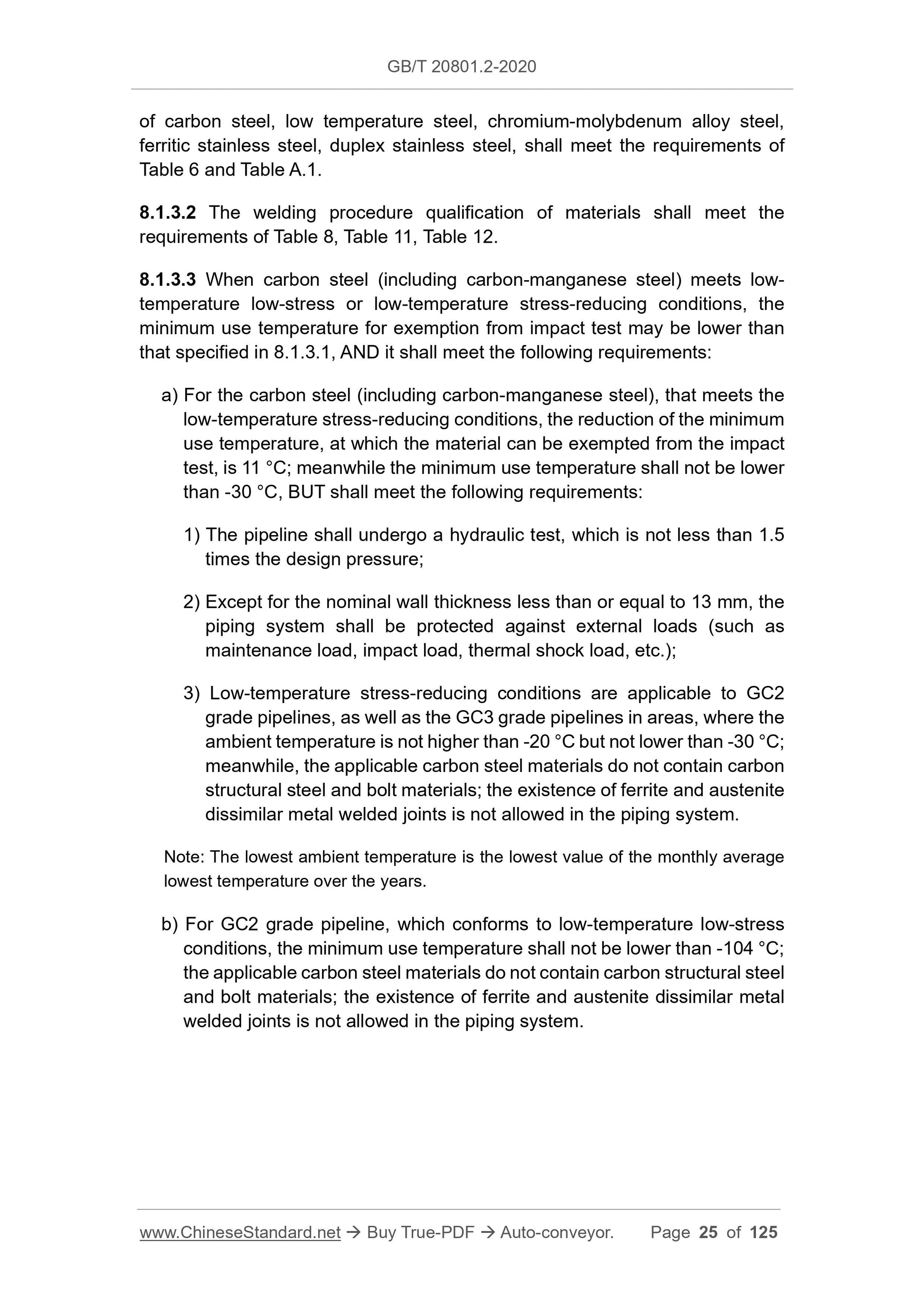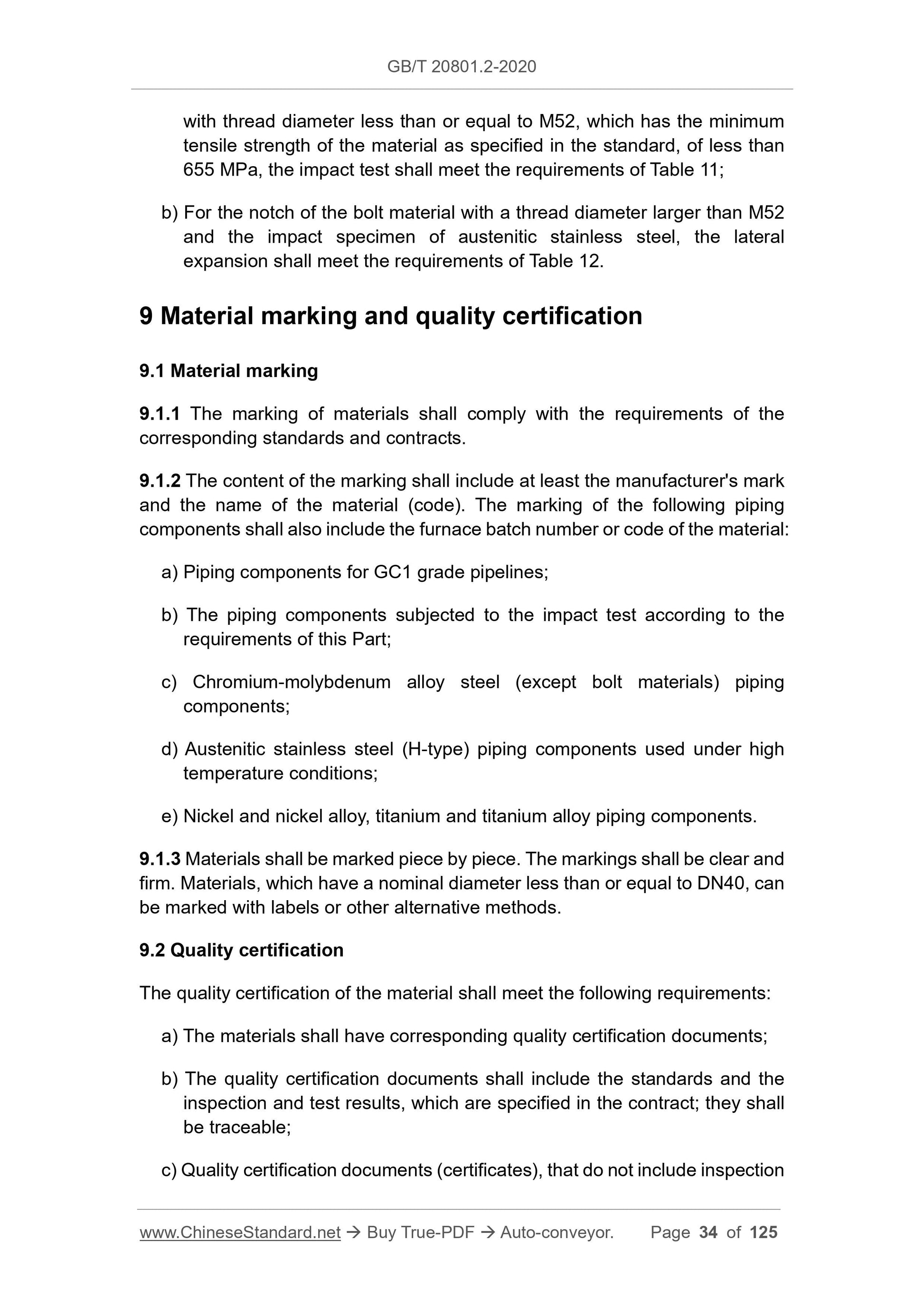1
/
de
12
PayPal, credit cards. Download editable-PDF and invoice in 1 second!
GB/T 20801.2-2020 English PDF (GBT20801.2-2020)
GB/T 20801.2-2020 English PDF (GBT20801.2-2020)
Prix habituel
$995.00 USD
Prix habituel
Prix promotionnel
$995.00 USD
Prix unitaire
/
par
Frais d'expédition calculés à l'étape de paiement.
Impossible de charger la disponibilité du service de retrait
Delivery: 3 seconds. Download true-PDF + Invoice.
Get QUOTATION in 1-minute: Click GB/T 20801.2-2020
Historical versions: GB/T 20801.2-2020
Preview True-PDF (Reload/Scroll if blank)
GB/T 20801.2-2020: Pressure piping code -- Industrial piping -- Part 2: Materials
GB/T 20801.2-2020
GB
NATIONAL STANDARD OF THE
PEOPLE’S REPUBLIC OF CHINA
ICS 23.040
J 74
Replacing GB/T 20801.2-2006
Pressure piping code - Industrial piping - Part 2:
Materials
ISSUED ON: NOVEMBER 19, 2020
IMPLEMENTED ON: JUNE 01, 2021
Issued by: State Administration for Market Regulation;
Standardization Administration of PRC.
Table of Contents
Foreword ... 3
1 Scope ... 5
2 Normative references ... 5
3 Terms and definitions ... 9
4 General rules ... 11
5 Basic principles of material selection ... 13
6 Restrictions on the use of materials ... 13
7 Restrictions on the use of materials under high temperature conditions ... 21
8 Restrictions on the use of materials under low temperature conditions ... 24
9 Material marking and quality certification ... 34
Appendix A (Normative) Material designation and allowable stress ... 36
Appendix B (Informative) Physical properties of materials ... 72
Appendix C (Informative) Risk-based material design and selection ... 78
Appendix D (Informative) Comparison of material standards and designations
between China and foreign countries ... 113
References ... 124
Pressure piping code - Industrial piping - Part 2:
Materials
1 Scope
This Part of GB/T 20801 specifies the basic requirements for materials for
pressure piping components, including the selection of materials, restrictions
on use based on material properties, marking and quality certification.
This Part applies to the selection and use of materials, for pressure piping
components, which are defined in the scope of GB/T 20801.1.
2 Normative references
The following documents are essential to the application of this document. For
the dated documents, only the versions with the dates indicated are applicable
to this document; for the undated documents, only the latest version (including
all the amendments) is applicable to this standard.
GB/T 229 Metallic materials - Charpy pendulum impact test method
GB/T 1220 Stainless steel bars
GB/T 1348 Spheroidal graphite iron castings
GB/T 2882 Nickel and nickel alloys tube
GB/T 3077 Alloy structure steels
GB/T 3087 Seamless steel tubes for low and medium pressure boiler
GB/T 3091 Welded steel pipes for low pressure liquid delivery
GB/T 3098.1 Mechanical properties of fasteners - Bolts, screws and studs
GB/T 3098.6 Mechanical properties of fasteners - Stainless steel bolts,
screws and studs
GB/T 3624 Titanium and titanium alloy seamless tubes
GB/T 4334 Corrosion of metals and alloys - Test methods for intergranular
corrosion of stainless steels
The owner or designer shall select appropriate materials for piping components,
according to the specific use conditions (including manufacturing, fabrication
and installation, media, operating conditions, working environment, testing, etc.)
AND the material use requirements and restrictions specified in this Part,
considering the risk of material damage. This Part does not include material
requirements for welding, non-metal, etc.
4.2 Material and technical requirements
4.2.1 Table A.1 and Table A.2 of Appendix A specify the designations, allowable
stress and application range of the piping component materials. The materials,
which are used for the piping components, shall comply with the requirements
of the material standards, as listed in Table A.1 and Table A.2.
See Appendix B for the physical performance parameters of the material. Refer
to Appendix C, for the selection of commonly used pipeline materials, damage
risks, corresponding material design requirements, engineering measures.
4.2.2 In addition to the materials listed in Table A.1 and Table A.2, the following
materials can be used for piping components; however, they shall meet the
requirements and use restrictions for corresponding materials in this Part:
a) Other designations of materials, which are listed in the applicable material
standards for industrial piping, as listed in Table A.1 and Table A.2;
b) The material meets the published material standards, including chemical
composition, physical properties, mechanical properties, manufacturing
methods and processes, heat treatment and quality control, etc. It is not
lower than the requirements of the corresponding material standards,
which are listed in Table A.1 and Table A.2;
c) Standard applicable materials for piping components, which are listed in
Table 13 of GB/T 20801.3-2020;
d) The foreign standard materials, which are listed in Appendix D,
corresponding to the materials listed in Table A.1 and Table A.2.
4.2.3 Materials with unknown designations shall not be used for piping
components.
4.2.4 The recovered materials shall not be used in piping components.
4.2.5 The selection of other materials shall be subject to technical appraisal and
review and approval, by institutions with corresponding qualifications.
5 Basic principles of material selection
5.1 The materials, which are used for pressure components (except bolts), shall
have sufficient strength, plasticity, toughness. They shall have sufficient
resistance to brittle fracture, at the lowest use temperature. When brittle
materials, which have an elongation rate of less than 14%, are used, it shall
take necessary safety protection measures.
5.2 The selected materials shall have sufficient stability, including chemical
properties, physical properties, corrosion and wear resistance, fatigue
resistance, organizational stability.
5.3 When selecting materials, it shall consider the applicability of the materials
under possible open flames, fires and extinguishing conditions, as well as
changes in material properties and secondary hazards, which are brought
about by this.
5.4 The selected materials shall be suitable for the corresponding
manufacturing, production, installation, including welding, cold and hot
processing, heat treatment requirements.
5.5 When several different materials are used in combination, it shall consider
the possible adverse effects.
5.6 Materials shall be available and economical.
6 Restrictions on the use of materials
6.1 Nodular cast iron, gray cast iron, malleable cast iron
6.1.1 Nodular cast iron
6.1.1.1 When nodular cast iron is used for piping components, its elongation
shall not be less than 15%; the use temperature shall not be higher than 350 °C,
but it shall be higher than -20 °C. The use restrictions of nodular cast iron piping
components, which are listed in Table 13 of GB/T 20801.3-2020, shall comply
with the corresponding requirements of GB/T 13295.
6.1.1.2 Except for GC3 grade pipes, nodular cast iron shall meet the impact
performance requirements of GB/T 1348; the pressure rating shall not exceed
5.0 MPa.
6.1.1.3 Nodular cast iron shall not be used in severe cyclic conditions.
6.1.1.4 In addition to meeting the requirements of 6.1.1.1, 6.1.1.2, 6.1.1.3, the
applicable pressure-temperature ratings of nodular cast iron pipes, fittings,
accessories, pipe flanges, valves shall also comply with the requirements of the
corresponding standards, in Table 13 of GB/T 20801.3-2020.
6.1.1.5 Welding is not allowed, during manufacturing, production, installation.
6.1.2 Gray cast iron and malleable cast iron
6.1.2.1 When the gray cast iron and malleable cast iron, which are listed in
Table A.1, are used for piping components, they shall meet the following
requirements:
a) The use temperature of gray cast iron piping components shall not ...
Get QUOTATION in 1-minute: Click GB/T 20801.2-2020
Historical versions: GB/T 20801.2-2020
Preview True-PDF (Reload/Scroll if blank)
GB/T 20801.2-2020: Pressure piping code -- Industrial piping -- Part 2: Materials
GB/T 20801.2-2020
GB
NATIONAL STANDARD OF THE
PEOPLE’S REPUBLIC OF CHINA
ICS 23.040
J 74
Replacing GB/T 20801.2-2006
Pressure piping code - Industrial piping - Part 2:
Materials
ISSUED ON: NOVEMBER 19, 2020
IMPLEMENTED ON: JUNE 01, 2021
Issued by: State Administration for Market Regulation;
Standardization Administration of PRC.
Table of Contents
Foreword ... 3
1 Scope ... 5
2 Normative references ... 5
3 Terms and definitions ... 9
4 General rules ... 11
5 Basic principles of material selection ... 13
6 Restrictions on the use of materials ... 13
7 Restrictions on the use of materials under high temperature conditions ... 21
8 Restrictions on the use of materials under low temperature conditions ... 24
9 Material marking and quality certification ... 34
Appendix A (Normative) Material designation and allowable stress ... 36
Appendix B (Informative) Physical properties of materials ... 72
Appendix C (Informative) Risk-based material design and selection ... 78
Appendix D (Informative) Comparison of material standards and designations
between China and foreign countries ... 113
References ... 124
Pressure piping code - Industrial piping - Part 2:
Materials
1 Scope
This Part of GB/T 20801 specifies the basic requirements for materials for
pressure piping components, including the selection of materials, restrictions
on use based on material properties, marking and quality certification.
This Part applies to the selection and use of materials, for pressure piping
components, which are defined in the scope of GB/T 20801.1.
2 Normative references
The following documents are essential to the application of this document. For
the dated documents, only the versions with the dates indicated are applicable
to this document; for the undated documents, only the latest version (including
all the amendments) is applicable to this standard.
GB/T 229 Metallic materials - Charpy pendulum impact test method
GB/T 1220 Stainless steel bars
GB/T 1348 Spheroidal graphite iron castings
GB/T 2882 Nickel and nickel alloys tube
GB/T 3077 Alloy structure steels
GB/T 3087 Seamless steel tubes for low and medium pressure boiler
GB/T 3091 Welded steel pipes for low pressure liquid delivery
GB/T 3098.1 Mechanical properties of fasteners - Bolts, screws and studs
GB/T 3098.6 Mechanical properties of fasteners - Stainless steel bolts,
screws and studs
GB/T 3624 Titanium and titanium alloy seamless tubes
GB/T 4334 Corrosion of metals and alloys - Test methods for intergranular
corrosion of stainless steels
The owner or designer shall select appropriate materials for piping components,
according to the specific use conditions (including manufacturing, fabrication
and installation, media, operating conditions, working environment, testing, etc.)
AND the material use requirements and restrictions specified in this Part,
considering the risk of material damage. This Part does not include material
requirements for welding, non-metal, etc.
4.2 Material and technical requirements
4.2.1 Table A.1 and Table A.2 of Appendix A specify the designations, allowable
stress and application range of the piping component materials. The materials,
which are used for the piping components, shall comply with the requirements
of the material standards, as listed in Table A.1 and Table A.2.
See Appendix B for the physical performance parameters of the material. Refer
to Appendix C, for the selection of commonly used pipeline materials, damage
risks, corresponding material design requirements, engineering measures.
4.2.2 In addition to the materials listed in Table A.1 and Table A.2, the following
materials can be used for piping components; however, they shall meet the
requirements and use restrictions for corresponding materials in this Part:
a) Other designations of materials, which are listed in the applicable material
standards for industrial piping, as listed in Table A.1 and Table A.2;
b) The material meets the published material standards, including chemical
composition, physical properties, mechanical properties, manufacturing
methods and processes, heat treatment and quality control, etc. It is not
lower than the requirements of the corresponding material standards,
which are listed in Table A.1 and Table A.2;
c) Standard applicable materials for piping components, which are listed in
Table 13 of GB/T 20801.3-2020;
d) The foreign standard materials, which are listed in Appendix D,
corresponding to the materials listed in Table A.1 and Table A.2.
4.2.3 Materials with unknown designations shall not be used for piping
components.
4.2.4 The recovered materials shall not be used in piping components.
4.2.5 The selection of other materials shall be subject to technical appraisal and
review and approval, by institutions with corresponding qualifications.
5 Basic principles of material selection
5.1 The materials, which are used for pressure components (except bolts), shall
have sufficient strength, plasticity, toughness. They shall have sufficient
resistance to brittle fracture, at the lowest use temperature. When brittle
materials, which have an elongation rate of less than 14%, are used, it shall
take necessary safety protection measures.
5.2 The selected materials shall have sufficient stability, including chemical
properties, physical properties, corrosion and wear resistance, fatigue
resistance, organizational stability.
5.3 When selecting materials, it shall consider the applicability of the materials
under possible open flames, fires and extinguishing conditions, as well as
changes in material properties and secondary hazards, which are brought
about by this.
5.4 The selected materials shall be suitable for the corresponding
manufacturing, production, installation, including welding, cold and hot
processing, heat treatment requirements.
5.5 When several different materials are used in combination, it shall consider
the possible adverse effects.
5.6 Materials shall be available and economical.
6 Restrictions on the use of materials
6.1 Nodular cast iron, gray cast iron, malleable cast iron
6.1.1 Nodular cast iron
6.1.1.1 When nodular cast iron is used for piping components, its elongation
shall not be less than 15%; the use temperature shall not be higher than 350 °C,
but it shall be higher than -20 °C. The use restrictions of nodular cast iron piping
components, which are listed in Table 13 of GB/T 20801.3-2020, shall comply
with the corresponding requirements of GB/T 13295.
6.1.1.2 Except for GC3 grade pipes, nodular cast iron shall meet the impact
performance requirements of GB/T 1348; the pressure rating shall not exceed
5.0 MPa.
6.1.1.3 Nodular cast iron shall not be used in severe cyclic conditions.
6.1.1.4 In addition to meeting the requirements of 6.1.1.1, 6.1.1.2, 6.1.1.3, the
applicable pressure-temperature ratings of nodular cast iron pipes, fittings,
accessories, pipe flanges, valves shall also comply with the requirements of the
corresponding standards, in Table 13 of GB/T 20801.3-2020.
6.1.1.5 Welding is not allowed, during manufacturing, production, installation.
6.1.2 Gray cast iron and malleable cast iron
6.1.2.1 When the gray cast iron and malleable cast iron, which are listed in
Table A.1, are used for piping components, they shall meet the following
requirements:
a) The use temperature of gray cast iron piping components shall not ...
Share
